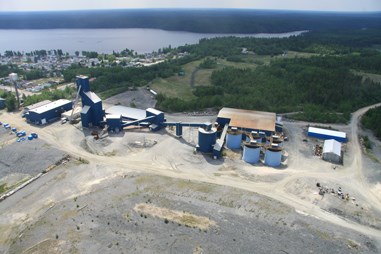With Hudbay’s May 4 purchase of the Snow Lake Mine (SLM), thoughts understandably go to why they would want it and what purpose the acquisition would have. There is still gold at depth in the old producer, but it’s not of a grade or volume that would normally interest a zinc/copper miner like Hudbay.
According to a feasibility study on the mine completed by QMX in November 2010, the mine could produce another 80,000 oz. of gold per year over five years, at average cash costs of US$640 per oz. (after an investment of $39.7 million). The study outlined measured and indicated resources of 5.47 million tonnes grading 4.24 grams gold per tonne for 728,000 contained oz. gold, and inferred resources of 2.37 million tonnes grading 4.43 grams gold for 336,700 contained oz. gold.
However, the mill is an asset that the company could use, as is the tailings capacity of the Birch Lake tailings impoundment area (TIA).
Hudbay’s Manitoba business unit vice-president Rob Winton advises that the purchase of the Snow Lake Mine assets offers Hudbay operational flexibility in maximizing the Lalor deposit. In an emailed statement, he said the carbon in pulp (CIP) process used at the Snow Lake Mine’s mill will allow Hudbay to maximize Lalor ore recoveries for precious metals. “Our immediate plans for the site are to continue the environmental obligations established and ensure those processes are improved to the Hudbay standard.” The company also noted in a May 7 news release that, if refurbished, the old mine’s mill has the potential to process approximately 2,000 tonnes per day of gold zone ore from the Lalor mine, and added that the CIP circuit has historically produced gold bars on site.
Winton advises that there are a number of technical and engineering studies required before Hudbay understands where the mine’s mill fits into local operations. “These studies will determine potential process changes, tailings composition, and the operational requirements of the mill to successfully process Lalor ores. Once these studies are complete and capital money secured, the Hudbay Manitoba operations in Snow Lake will be understood and shared.”
Although mill tailings discharge into the Birch Lake TIA, and from there into Herblet Lake (not Snow Lake), the pond’s proximity to the community and Snow Lake has caused concerns in the past. This may be heightened given Lalor rock is acid generating, whereas Nor-Acme/New Brit’s was not. However, Winton says regardless of the composition of tailings, the effluent discharged from the tailings pond must meet the same strict criteria prescribed by federal regulations made under the Fisheries Act. “Hudbay expects to meet or exceed the applicable water quality standards in all of its facilities, and this one will be no exception,” he said. “The tailings facility will be operated and managed with the same rigour as other Hudbay tailings facilities. This will include visual inspections, effluent assays, and annual 3rd party dam safety reviews by geotechnical experts.”
As for the capacity of the Birch Lake TIA, Winton says it will be one of the key studies undertaken. “Information from QMX suggests there is 1.5 million tonnes available; with minor alterations to achieve 3.5 million tonnes.”
The Snow Lake Mine has a long and storied past, bookmarked with multiple lives spanning six decades, two separate centuries, and a couple of millenniums. Initial operation occurred from 1949 to 1958, during which approximately five million tons of ore were mined. Tailings from the initial operation were discharged into Birch Lake north of the mine, although some tailings were also discharged to the area east of the original mill (old Hudbay Machine Shop). An environmental cleanup of this area wraps up this year at the cost of over $1 million to the provincial government.
The mine was re-opened in 1995 and operated until 2005 as the New Britannia Mine. During this second period of operations, tailings disposal was re-activated at Birch Lake. In order to do this, tailings/water impoundment structures were constructed to provide additional containment for tailings solids, supernatant, and runoff water.
The company further advised in their May 7 release that they expected to require a paste backfill plant for Lalor Mine in addition to the refurbishment of the Snow Lake Mine mill. They say ore from Lalor will continue to be processed at their Stall concentrator, while engineering work is carried out on a potential restart of the SLM mill. They anticipate that the results of a technical study on the mill, including the estimated costs and timing of a potential restart, will be available in 2016, and as a result they no longer expect to construct a new concentrator at the Lalor site.
If and when Hudbay goes ahead with their plans, Winton states that they will apply for all necessary licences associated with the activities and operations at the Snow Lake Mine site and that a Notice of Major Alteration to the existing licence would involve stakeholder engagement meetings.




